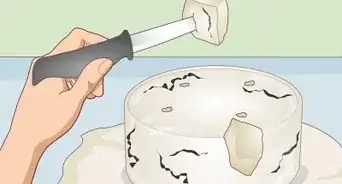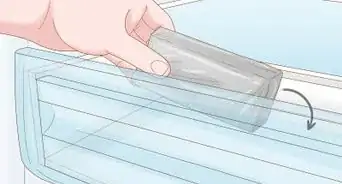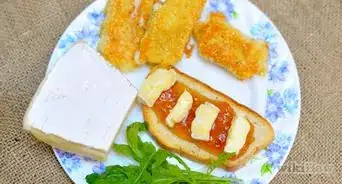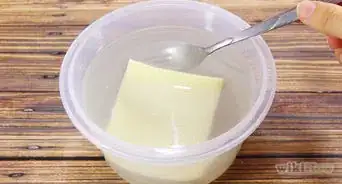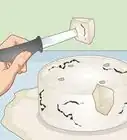This article was co-authored by Abyssinia Campbell and by wikiHow staff writer, Aly Rusciano. Abyssinia Campbell is an Executive Chef and the Owner of Chef Abyssinia, Personal Chef and Catering. With over ten years of experience, she specializes in catering, event planning, menu development, meal planning, and food business operations. When it comes to cooking, Chef Abyssinia enjoys using fruits, vegetables, healthy food alternatives, and local farm-fresh ingredients. She holds a BASc in Culinary Arts and Food Service Management from Johnson and Wales University.
There are 15 references cited in this article, which can be found at the bottom of the page.
This article has been viewed 117,886 times.
Looking to get that perfect cheese slice? Cutting cheese can seem difficult, especially when there are so many different kinds, but it’s not nearly as hard as you may think. Whether you want to serve a charcuterie board or make a cheese sandwich, we’ve got all the tips and tricks you need. Keep reading to learn how you can slice cheese for any and all occasions.
Steps
Wedges
-
1Chop a semi-hard or hard wedge width-wise for thinner slices. Lay the cheese wedge on its side. Start at the tip of the wedge and slice down the width, making a cut every 1⁄4 to 3⁄4 inch (0.64 to 1.91 cm).[1]
- If your wedge is on the larger side, try cutting it in half first for shorter slices.
- Try using a core knife for clean cuts, as this knife is specifically designed to cut cheese.
- This cut works well with cheddar, asiago, goya, and romano cheeses.
-
2Cut a wedge of crumbly cheese on a bias for a rustic chop. Lay the wedge of cheese on its side with the tip facing you. Center the tip of your knife on the tip of the cheese wedge. Angle the knife to cut a wedge at a 45-degree angle. Keep the knife tip in the center of the cheese and continue cutting in a radial pattern, with each slice being between 1⁄4 to 2⁄3 inch (0.64 to 1.69 cm) thick.[2]
- Use a flat cheese knife to cut crumbly pieces purposefully.
- This cut works well with bleu, feta, and asiago cheeses.
Advertisement -
3Slice soft-ripened cheese wedges on a diagonal. Press your knife into the cheese at the top corner with the blade reaching from the top edge to the side edge. Keep slicing until you reach the tip of the cheese.[3]
- This cut works well with cold soft-ripened cheeses like brie and camembert.
Wheels or Rounds
-
1Cut soft, medium, and hard cheeses into 1 to 2 inches (2.5 to 5.1 cm) wedges. A wheel of cheese can easily be sliced into smaller cake-like sections to serve and eat. Use a sharp knife to slice into the cheese, resting the tip of the knife in the center of the wheel. Move the end of the knife closest to the handle over 1 to 2 inches (2.5 to 5.1 cm) and slice again. Do this around the whole wheel or only cut a few slices to display the wheel on a platter.[4]
- Use thin bladed or soft cheese knife when cutting circular cheeses to avoid getting large chunks of cheese sticking to the knife.[5]
- This cut works well with all cheese wheels; just make sure soft cheeses are chilled to keep their shape while cutting.
-
2Serve short cheese rounds as sliced wedges. If you’re making a cheese platter or charcuterie board, consider cutting circular cheeses of all varieties like a piece of pie. First, slice the wheel in half. Then, slice a half in half. Take this quarter piece and use even strokes, starting at the tip of the wedge, to create smaller wedges.[6]
- Always keep the tip of the knife at the center of the cheese.[7]
- If you have a smaller wheel, cutting the cheese in half and making wedges from that may be enough to serve.
- The size of your wedges is entirely up to you! But remember, a typical serving size of cheese is 1 ounce (28 g).
- This cut works well with brie, belstone, and pecorino cheeses.
-
3Break down tall hard round cheeses into 1⁄4 inch (0.64 cm) slices. First, cut the wheel into wedges—splitting it in half, then half again, and then into pie-like wedges. Next, put the wedge on its side with the rind facing you. Slice the cheese vertically from the tip to the rind.[8]
- Consider cutting the slice in half if the serving is too large or you have a very tall wheel of cheese.[9]
- If your cheese has a rind on the top, slice that part off before making individual serving slices.[10]
- Use a long, large bladed knife, such as a cleaver, when handling hard cheeses as they can be thick to cut through.[11]
- This cut works well with parmigiano, Emmental, and gruyere cheeses.
Blocks
-
1Chop semi-hard cheese blocks into triangles. Cut the cheese block in half, so you have 2 rectangular pieces of cheese. Next, slice each half into 1⁄8 inch (0.32 cm) thick rectangular pieces using vertical cuts. Then, chop at a diagonal from corner to corner to create a triangle.[12]
- This cut works well with cheddar, monterey jack, and gouda cheeses.
-
2Sweep a wire cheese slicer over semi-hard or hard cheese for thin slices. Place the block of cheese on its side, holding it in place with one hand. Take a wire cheese slicer or cutter and set the wire part over the edge of the cheese. Use gentle pressure to push the wire through the cheese until you reach the bottom.[13]
- Some wire cheese slicers have an adjustment feature that lets you determine the thickness of each slice.
- A thicker version of this cut can also be done with a sharp knife.
- This cut works well with cheddar, swiss, and gouda cheeses.
-
3Glide a cheese plane over wide cheese blocks for thin sheet slices. Cheese planes are basically hand held cheese graters and create paper-thin slices for crackers, rolls, or sandwiches. Place the block of cheese on its shorter side, and position your cheese plane at the top flat edge. Drag the plane slowly and firmly over the cheese.[14]
- Place the block on its longer side for longer cheese slices.
- This cut works well with cheddar, swiss, and Emmental cheeses.
References
- ↑ https://www.thrillist.com/travel/nation/cutting-the-cheese-how-to-cut-the-cheese-like-a-frenchman
- ↑ https://youtu.be/OCGchOL7djY?t=131
- ↑ https://youtu.be/uKrXuU1uuDo?t=441
- ↑ https://youtu.be/1w6a5jNCb5k?t=182
- ↑ https://youtu.be/HXr46lqBSsI?t=60
- ↑ https://youtu.be/HXr46lqBSsI?t=71
- ↑ https://youtu.be/HXr46lqBSsI?t=92
- ↑ https://youtu.be/UvzDXu0EOzg?t=87
- ↑ https://youtu.be/UvzDXu0EOzg?t=121

